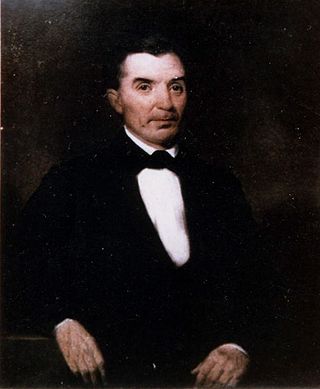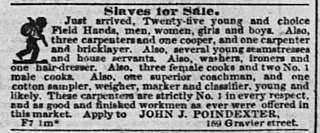Related Research Articles
Dred Scott v. Sandford, 60 U.S. 393 (1857), was a landmark decision of the United States Supreme Court that held the U.S. Constitution did not extend American citizenship to people of black African descent, and thus they could not enjoy the rights and privileges the Constitution conferred upon American citizens. The decision is widely considered the worst in the Supreme Court's history, being widely denounced for its overt racism, perceived judicial activism, poor legal reasoning, and crucial role in the start of the American Civil War four years later. Legal scholar Bernard Schwartz said that it "stands first in any list of the worst Supreme Court decisions". Chief Justice Charles Evans Hughes called it the Court's "greatest self-inflicted wound".

Edward Douglass White Jr. was an American politician and jurist. White, a native of Louisiana, was a U.S. Supreme Court justice for 27 years, first as an associate justice from 1894 to 1910, then as the ninth chief justice from 1910 until his death in 1921. White is known for siding with the Supreme Court majority in Plessy v. Ferguson, which upheld the legality of state segregation.

Wilbert Rideau is an American convicted killer and former death row inmate from Lake Charles, Louisiana, who became an author and award-winning journalist while held for 44 years at Angola Prison. Rideau was convicted in 1961 of first-degree murder of Julia Ferguson in the course of a bank robbery that year, and sentenced to death. He was held in solitary confinement on death row, pending execution. After the Supreme Court of the United States ruled that states had to rework their death penalty statutes because of constitutional concerns, the Louisiana Court judicially amended his sentence in 1972 to life in prison.

Antoinette Renee Frank is a former officer of the New Orleans Police Department (NOPD) who, on March 4, 1995, committed a violent armed robbery at a restaurant which resulted in the killing of two members of the Vietnamese-American family who ran the establishment, and fellow NOPD officer Ronald A. Williams II. She was aided by her probable lover, drug dealer Rogers Lacaze. Frank is currently incarcerated at the Louisiana Correctional Institute for Women in St. Gabriel, Louisiana, the only woman on the state's death row.

Isaac Franklin was an American slave trader and plantation owner. He was the co-founder of Franklin & Armfield, which became the largest slave trading firm in the United States. Based in Alexandria, Virginia, it also had offices in Natchez, Mississippi; New Orleans and other Louisiana cities. Franklin owned a total of six plantations in Tennessee and Louisiana. His Fairvue plantation, in Gallatin, Sumner County, Tennessee, was formerly listed on the National Register of Historic Places.
Sally Miller, born Salomé Müller, was an American woman enslaved sometime in the late 1810s, whose freedom suit in Louisiana was based on her claimed status as a free German immigrant and indentured servant born to non-enslaved parents. The case attracted wide attention and publicity because of the issue of "white" slavery. In Sally Miller v. Louis Belmonti, the Louisiana Supreme Court ruled in her favor, and Miller gained freedom.

Jean-Pierre Chouteau was a French Creole fur trader, merchant, politician, and slaveholder. An early settler of St. Louis from New Orleans, he became one of its most prominent citizens. He and his family were prominent in establishing the fur trade in the city, which became the early source of its wealth.
Lynette Boggs-Perez is a former Republican politician in Clark County, Nevada, and Bexar County, Texas, and the winner of the Miss Oregon 1989 scholarship pageant. She went by the name of Lynette Boggs McDonald for most of her political career and returned to her maiden name after a 2007 divorce. She remarried in 2017 and both personally and professionally is known as Lynette Boggs-Perez.

Marguerite Scypion, also known in court files as Marguerite, was an African-Natchez woman, born into slavery in St. Louis, then located in French Upper Louisiana. She was held first by Joseph Tayon and later by Jean Pierre Chouteau, one of the most powerful men in the city.
Corey Miller, better known by his stage name C-Murder, is an American rapper. He initially gained fame in the mid-1990s as a part of his brother Master P's label No Limit Records, primarily as a member of the label's supergroup, TRU. Miller went on to release several solo albums of his own through the label, including 1998's platinum Life or Death. C-Murder has released nine albums altogether on six different labels, No Limit Records, TRU Records, Koch Records, Asylum Records, RBC Records, and Venti Uno.
Blueford v. Arkansas, 566 U.S. 599 (2012), was a decision of the Supreme Court of the United States that clarified the limits of the Double Jeopardy Clause. The Supreme Court held that the Double Jeopardy Clause does not bar retrial of counts that a jury had previously unanimously voted to acquit on, when a mistrial is declared after the jury deadlocked on a lesser included offense.

Robert Wash served on the Supreme Court of Missouri from September 1825 to May 1837. During his term, the pro-slavery judge, who owned slaves himself, wrote the dissenting opinion on several important freedom suits, including Milly v. Smith, Julia v. McKinney and Marguerite v. Chouteau. However, he did join in the unanimous finding for the plaintiff in the landmark Rachel v. Walker case.
Winny v. Whitesides alias Prewitt was the first freedom suit heard by the Supreme Court of Missouri. The case established the state's judicial criteria for an enslaved person's right to freedom. The court determined that if a slave owner took a slave into free territory and established residence there, the slave would be free. The slave remained free even if returned to slave territory, engendering the phrase "once free, always free."
Ramos v. Louisiana, 590 U.S. ___ (2020), was a U.S. Supreme Court decision in which the Court ruled that the Sixth Amendment to the U.S. Constitution requires that guilty verdicts be unanimous in trials for serious crimes. Only cases in Oregon and Louisiana were affected by the ruling because every other state already had this requirement. The decision incorporated the Sixth Amendment requirement for unanimous jury criminal convictions against the states, and thereby overturned the Court's previous decision from the 1972 cases Apodaca v. Oregon and Johnson v. Louisiana.
Hall v. Decuir, 95 U.S. 485 (1878), was a decision of the Supreme Court of the United States. In Hall, Josephine Decuir, a wealthy woman designated a Creole, sued for racial discrimination she experienced on a steamboat. She was traveling from New Orleans to Pointe Coupee Parish, where she owned a sugar plantation.

Richard Barry Sobol was an American lawyer who specialized in civil rights law. He worked primarily on desegregation cases in Louisiana.

Shadrack Fluellen Slatter, usually listed as S. F. Slatter in advertisements and often called Col. Slatter in later life, was a 19th-century American slave trader and capitalist. In the 1830s and 1840s he was part of the coastwise slave trade in partnership with his older brother Hope H. Slatter, who bought slaves in Baltimore for S. F. Slatter to sell at New Orleans. It was typical for interstate traders like the Slatters to have a buying location in the Upper South and a selling location in the Lower South. After quitting the retail slave trade, he was a real estate developer and landlord in New Orleans. In the late 1850s he was heavily involved in promoting and funding the freelance invasion of Nicaragua by William Walker.

John Jenkins Poindexter was an American slave trader, commission merchant, school commissioner, and steamboat master of Louisiana and Mississippi. He served in the Mexican-American War as a junior officer in the Mississippi Rifles. The historic John J. Poindexter House in Jackson, Mississippi, was commissioned for the young Poindexter family and designed in the 1840s by architect William Nichols.

Jonathan Means Wilson, usually advertising as J. M. Wilson, was a 19th-century slave trader of the United States who trafficked people from the Upper South to the Lower South as part of the interstate slave trade. Originally a trading agent and associate to Baltimore traders, he later operated a slave depot in New Orleans. At the time of the 1860 U.S. census of New Orleans, Wilson had the second-highest net worth of the 34 residents who listed their occupation as "slave trader".

John Rucker White was an American slave trader who was primarily active in Missouri and Louisiana, but also trafficked in people from Kentucky and Virginia. He has been described as "by far the largest and most successful slave trader who operated in the mid-Missouri area." According to a 1914 history of slavery in Missouri, "John R. White of Howard County was a wealthy planter of good repute who dealt in slaves. He lived on a farm of 1053 acres and was taxed with 46 negroes in 1856." Howard County lies along the banks of the Missouri River, a tributary of the Mississippi River, in a section of Missouri known as Little Dixie, which had plantation slavery very much in the style of the Deep South. There is a "John R. White, Slave Record Book (1846–1860)" in the Chinn Collection of the Missouri Historical Society in St. Louis, from which researchers of slavery garner, "For traders in the lower Mississippi River valley, the most significant development was the arrival of steamboats during the 1820s. Most large traders in that region, such as John White from Missouri, used these vessels to transport the hundreds of Missouri, Kentucky, and Virginia slaves that they and their agents bought each year to Louisiana and other states in the Deep South."
References
- 1 2 3 4 5 6 7 8 9 10 11 12 13 14 15 16 17 18 Johnson, Walter (June 2000). "The Slave Trader, the White Slave, and the Politics of Racial Determination in the 1850s". The Journal of American History . 87 (1): 13–38. doi:10.2307/2567914. JSTOR 2567914.
- 1 2 3 4 5 6 7 8 9 10 11 12 "Morrison v. White". Encyclopedia of Arkansas History & Culture.
- 1 2 Supreme Court, Louisiana (1866). Reports of Cases Argued and Determined in the Supreme Court of Louisiana. p. 102.
This article needs additional or more specific categories .(June 2023) |